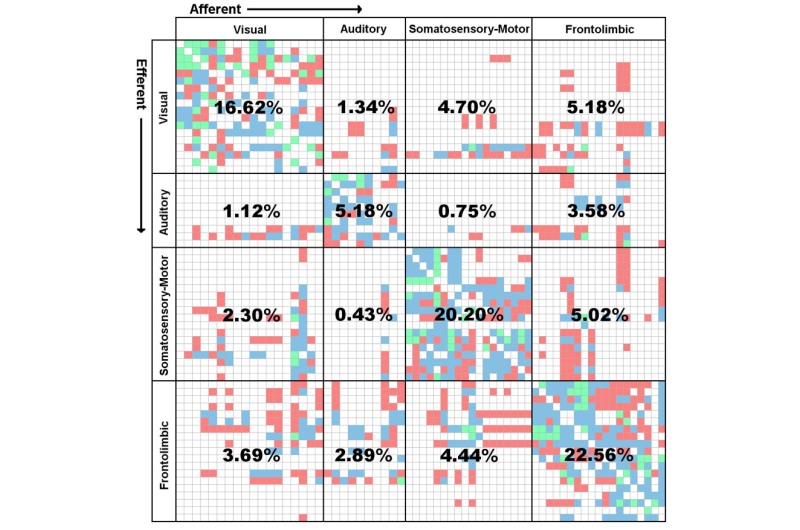Cluster analysis of cat neural network models reveals promising anti-seizure strategies

An international team of investigators from Brazil, Scotland and Germany is expanding the research base on the brain's complex suite of connections known as neural networks using computer simulations and a technique called cluster analysis. Basically, they built a computer model of a cat brain's corticocortical network separated into 65 areas and connected by fibers of different densities. The areas were separated into four clusters, or cognitive regions: visual, auditory, somatosensory-motor, and frontolimbic.
The researchers subjected the computer model to seizure-like conditions and tested three different ways to control or avert seizure-like electrical patterns in the computer model. Their results appear in the current edition of the journal Chaos. In it, the team reports results of its investigation into the specific seizure-related problem known as synchronization suppression using cluster analysis to evaluate three interventions.
Results show that of the three methods with therapeutic potential for correcting electrical disorders in the brain, the delayed feedback control is the most productive for synchronization suppression. The other two methods for achieving synchronization suppression that the team analyzed were external time-periodic driving and activation of selected neurons.
"We investigated the destruction of synchronization in a realistic neural network model whose connecting architecture is formed by a cluster of sub-network, and we found the most significant and interesting aspect to be the verification that the efficiency of synchronization suppression by delayed feedback control is higher and more efficient than for the two other methods: external time-periodic driving and activation of selected neurons. And importantly, the delayed feedback control is an intervention that does not damage the neurons," said Antonio M. Batista, Ph.D., the team leader of the study from the Department of Mathematics and Statistics at State University of Ponta Grossa, Brazil.
Cluster analysis refers to an algorithm-based method commonly used to identify, classify and compare objects being studied into structures—clusters—that share a similar measure. It is broadly used in many disciplines to analyze a range of characteristics, from pattern recognition to economic data to textual analysis and biological parameters, in this case analyzing the brain's electrical output.
It has long been documented that the mammalian brain has a cerebral cortex that features complex networks, and is involved in cognitive functions and complex perceptual tasks. There is also substantial literature on cortical networks in the cat cerebral cortex. Clinical evidence points to problems with synchronization of a small group of neurons as playing a key role in some pathological conditions such as Parkinson's disease, tremor, and epilepsy.
"For this reason, it is important to study ways to control or suppress neuronal phase synchronized bursting rhythms to restore normal spiking-bursting activity in a neuronal network," Batista said. Their hope is that a novel analytic approach using cluster analysis will have high practical value in identifying productive potential paths for future treatments. "Studies about suppression of synchronization are important due to their link with mental illness," Batista explained.
More information: Suppression of phase synchronisation in network based on cat's brain, Ewandson L. Lameu, Fernando S. Borges, Rafael R. Borges, Kelly C. Iarosz, Ibere L. Caldas, Antonio M. Batista, Ricardo L. Viana, and Jurgen Kurths, Chaos April 19th, 2016. DOI: 10.1063/1.4945796
Journal information: Chaos
Provided by American Institute of Physics



















